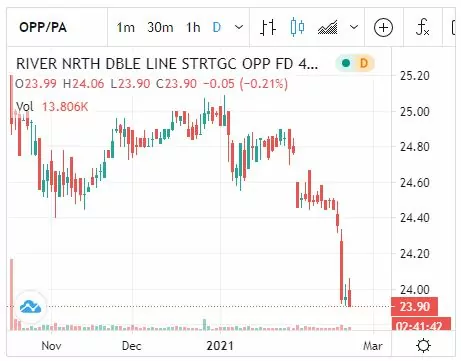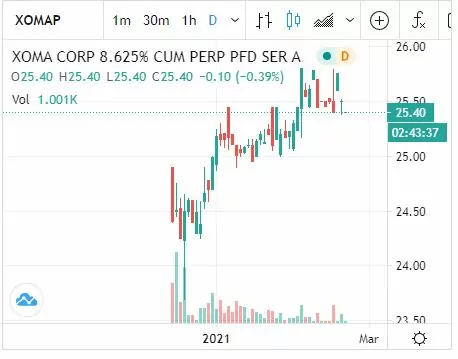January was a very good month for me with lots of dividends/interest showing up in account and share prices holding steady. February not so good–but no surprise to me.
I had begun to move out of the higher quality issues a few months ago–primarily because many were very overvalued–Gabelli CEF preferreds etc, but I purposely didn’t move out of all of them. Reflecting on my history I have never been one to stick around and wait for capital losses, but I have moved on to a different stage in my income investing. This means I keep holding some issues just because of their quality–choosing quality (safety) for a small portion of my holdings–a very safe income stream which is blended with junkier issues.
Balancing the high quality holdings I have added higher coupon issues–more risk, but less reactive to higher interest rates.
So here are a few of the results of that move.
Quality issues have suffered. Shown below are charts of 2 investment grade preferred issues and their poor share price performance during the last number of weeks. The Rivernorth/Doubleline Opportunity Fund (OPP-A) which is A1 rated by Moodys has been beaten badly with the modest 4.375% coupon.


Below are two junkier holdings I have. The Vornado Realty 5.70% (VNO-L) ,which is now callable, has traded flat–I will take flat.
The second is a newer issue of biotech royalty company Xoma. This 8.625% issue (XOMAP) is trading strongly in spite of higher interest rates-additionally because it was a newer issue trading under $25 liquidation preference investors were drawn to the value pricing (in the eyes of the beholder of course).


So we see the very typical pattern during times of interest rate increases–quality trades weak while junk trades relatively flat. Income investors demand a higher yield as interest rates increase–so they sell the low coupons to move to riskier issues.
The question then becomes should an investor buy more of the quality issues as rates rise? If you liked it at $25 should you love it at $24?
This depends on your opinion of interest rate movements and what you goals and objectives are at this point in your life.
I believe rates will likely continue to creep higher (hopefully slowly) as massive amounts of money chase goods and services causing some inflation. Being that I am 68 this year I also like the safety of investment grade issues. For me YES I will buy more as prices fall–I unloaded issues a month or two ago as their prices were out of control to the upside, but as they fall I will have to choose my buy points and start increasing my quality positions again.
For the month of February I am pretty much breakeven, which I am happy with as rates have risen–but I think March will be better unless we have an ‘event’.

First off I want to thank Tim and the rest for sharing. Tim never recommends what you should do and its different for each investor. What I like with this site is everyone sharing.
I hope everyone this past week was able to deal with the cold. We haven’t heard from Tex so hoping he is doing good.
Life changes and isn’t static, I hate losing principal as Tim mentioned. The 3 or 4 times it happened about 1/2 was out of my control and the other half was my fault. A year ago almost all of us were not expecting a “event” and I was almost fully invested. I hear people talk about you don’t lose until you sell and people panic and do just that. Well, I didn’t panic but I did wait a little and took a risk of selling losers to re-invest in the quality issues that as Grid says he welcomes back a old friend. I also sold other issues “Quickly” that I knew were not going to recover like the Leisure and Hospitality. Couple times before I rode a few investments down hoping they would recover only for them to go BK.
It is hard sometimes to keep track of investment opportunities so we watch and flip what we feel comfortable about. Tim mentions XOMAP which is in the wheelhouse of a preferred stock, so less volatility, I have played with HQL and HQH ( not preferred ) in the 16 to 20 price range so too rich now. But I keep a eye on it.
I may be a little early to F2F and I know it has nothing to do with treasuries, but sometimes its the general public’s impression we can take advantage of.
The question on rates is who benefits and who gets hurts and when that rolls over. Companies like RILY take a risk to loan high in a low rate environment but what happens with the business model when rates go up?
We all would like to know what next week brings, good luck to everyone
OPP-A and these other ‘investment’ grade preferred should be trading where Yield on Cost is still at least 5%, if not 6%.
LTVS – why do you say that? With OPP-A being A-1 rated, and given the required 200% Asset Coverage ratio, I’d think it would be pretty difficult to come up with a comparison that justifies a price like you’re suggesting, even 5%… especially given the Mandatory Redemption under Contingent Conversion Feature that could come into play some time this year… What am I missing? What comparisons do you have in mind? BTW, I do not own this one….. just kind of curious..
“ Mandatory Redemption under Contingent Conversion Feature that could come into play some time this year”
I don’t think many know about this. It’s probably a 50-50 shot of it happening and OPP-A getting redeemed at par this year. 4% upside from Friday’s close.
It’s actually kind of strange language but conversion to open end and therefore call of OPP-A is in the realm of possibility to a high enough degree of possibility to theoretically impact the price positively imho. I say strange language because what it says under the title, “MANDATORY Redemption under the Contingent Conversion Feature” is “In such event, the Fund MAY redeem the Series A Preferred Shares, without penalty or premium, at any time prior to such conversion…” You would think were it mandatory, they’d say WILL or IS REQUIRED TO, but they don’t….
The operative part of “may” is “without penalty or premium”. It is generally not callable at this time, exception for this one scenario.
I think part of what OPP shareholders will vote on as part of an open end conversion is the elimination of leverage which means the preferreds will be redeemed. Given the large discount OPP trades at, the conversion will be quite profitable as it will eliminate the discount.
I’m surprised at the weakness of CEF preferreds relative to IG. OPP-A is much safer and has a little higher yield than most/all the IG IPOs this year. GAB-K got rich at 27+ but at 26, it’s a solid 4.8% yielder that has plenty of call protection and is unlikely to be called when callable (lowest coupon of like a dozen Gabelli preferreds).
Same. I’ve been selling quality over the last couple of months and have gotten junkier. Now with some of the junk pricing in very rosy scenarios, I’m willing to peel off junk and add to quality names trading under par. Gradually taking what the market is giving.
Higher interest rates indicate a perception of inflation and a stronger economy. Higher yield paper holds up better now because the credit improvement resulting from a better economy counteracts the effect of higher rates. Anybody have any oil debt ideas?
Tim, I’m also following the same strategy.
Interest rates slowly bleed up and issues like OPP.A and USB.Q take a spanking to maybe some decent yield of >5%.
Then we mount our offensive and strike !!
EP.C is holding strong
Im wondering when we will see the same treatment of lower yielding muni bonds
Pickle,in regards to muni’s, I put some of my wife’s account in a muni mutual fund ladder w/ 1/3,1/3,1/3 in 3 invesco funds to limit duration and interest rate risks as much as possible over a year ago, its doing just what was expected. Short duration up 6.19% intermediate up+- 1% long up 1.23% but just rolled over with the rate spikes all are high quality funds avg. AArated. Haven”t done a detail analysis but our straight muni bonds have lost value over the last several days but after being up 10% over basis, that was to was expected, not being a trader of bonds those are in our sock drawer to maturity. May be “off limits” but surely, muni’s are part some of your balanced portfolio’s?
Hi Mike,
I guess I have to correct myself.
I have been looking at muni ETF which have a mix of durations. I was comparing those basket of funds against single income securities and not seeing the same grind down in price.
However, I was looking at the span of over the past year. I click a few buttons and the charts narrow to the last month and there is a slippery slope in muni bonds prices. So your observations are correct.
Eventually I would like to have muni in my sock drawer – taxable muni in a tax differed account (Roth) – and federal tax free muni in a taxable account.
But this interest rate thing may take a long time to work out to get to the point the yields on muni are good enough for me. We all should have bought bitcoin 10 years ago at $1.
“Ditto” Pickle, I was lucky we had cash 2-3 years back when rates were rising, stocked up with laddered 9-13 year durations around 3 %, all in state Indiana, worst of the bunch were aa- utilities? I could use some taxable’s also in roth &IRA , almost all my BAB’s are matured or called from back 10 years. Thought with all this stimulus floating around they might restart that BAB program only problem 2-3% this go round rather than 6-7% before, easier to just print money I guess. That tax free mutual fund ladder was my last muni endeavor only to replace tax frees that were called pickings terrible for a couple years?
I’m still holding on to my Gabelli preferreds. With some opportunistic trading 5% return becomes 7 or 8%. Never bought any forever preferreds under 5%